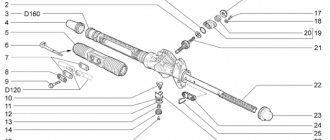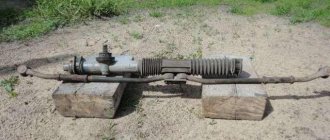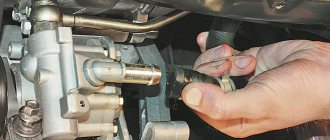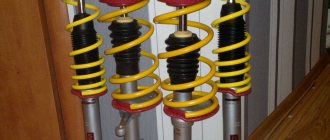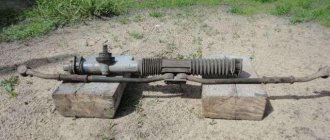The cost of a Lada Priora steering rack in Russia varies from 1,900 to 18,480 rubles .
The steering rack on the VAZ 2170 (first generation from 2007 to 2022) is one of the main control elements, which is responsible for transmitting force from the steering wheel to the rods and wheels. The rack consists of a housing and a shaft located inside with a toothed part. Control occurs through contact of the steering shaft with the rack teeth, which forms a worm gear.
The purchase of a new rack may be required if the contacting planes, regular and thrust bearings have obvious mechanical wear. Buy a pair of bearings for 700 rubles . and a repair kit for 400-900 rubles . It’s not entirely logical if a copy of a working original rack costs 1,900 rubles . The guaranteed mileage, subject to correct installation and the use of straight rods and pins, is at least 50,000 km .
By repairing the steering, you can not only restore the performance of the system, but also improve it. Tuned steering racks are available for sale in a standard housing, but with a reduced number of steering revolutions from 4.1 to 3 . The price of such slats starts from 6,240 rubles . with the necessary set of rods and fingers.
What affects the cost?
The main criterion for cost remains quality. The latter, in its best manifestations, is achievable within the framework of AvtoVAZ factory production or manual production of modernized steering racks. In addition, the following parameters of the product affect the cost:
- Availability of a power steering system (rack with an additional mechanism and line for connection)
- Equipped with rods with pressed-in fingers (thrust ball diameter of the finger, type of liner)
- Providing boot, clamps, retaining rings.
- Use of new seals, thrust plates and disc springs.
Some models of steering racks are equipped with a metal protective casing. Its price starts from 269 rubles . for a model without mounting kit and 370 rubles . with nuts, washers, studs.
When does the steering rack need to be tightened on a Priora?
The steering rack is a vulnerable point for the Lada Priora.
The first sign indicating the need to adjust the rack is the appearance of a knocking sound when driving over small uneven surfaces. The knocking will be felt especially clearly when driving on country roads. In this case, the driver will feel shocks and vibrations on the steering wheel, which will also be transmitted to the entire car body.
In addition, if the steering wheel adjustment nut is loosened when driving on the highway, the car will “float” a little, and additional steering will be required from the driver, which will also immediately become noticeable.
Experts also say that a tightening is necessary if the driver begins to notice the appearance of a clearly audible crunching sound in the area of the steering column, as well as an increase in the amplitude of the steering wheel rotation.
Types of goods and how much do they cost?
Since the VAZ 2170 was produced in a single generation, from 2007 to 2022, its steering rack has only two types, namely:
- With hydraulic booster - from 9,000 to 14,400 rubles.
- Without power steering – from 1,900 to 6,347 rubles.
Also within the framework of the original production, one can highlight the shortened steering rack 11183-3400010-10 with rods and ends. Full rotation of the steering wheel is only 3.1 turns.
11183-3400010-10
Also, division into types can be carried out within the framework of the origin of the product, namely:
- Original - 6,132-18,480 rubles.
- Analog – 1,900-7,819 rub.
By analogue we mean a product that, through practical testing, has received useful changes that have a positive effect on driving. At the same time, this also includes the category of cheaper substitutes, usually made in China.
Removing the Priora steering rack
You will need : remove the front wheels and prepare tools (a 13mm socket, a 15mm wrench, a 19mm spanner, a large slotted screwdriver, pliers, a mounting blade and a hammer).
Inside, remove the lower part of the intermediate shaft from the splines of the gear shaft:
- Unscrew the fastening bolt nut using a 13mm socket.
- Pull out the bolt.
- Release the terminal connection using a large slotted screwdriver.
- Remove the lower part of the intermediate shaft from the splines of the pinion shaft.
To remove the Priora steering rack without tie rods, disconnect the inner tie rod ends from the steering mechanism:
- Remove the retaining plate for the inner tie rod ends by using a flathead screwdriver.
- Unscrew one bolt completely using a 15mm spanner and loosen the other bolt.
- Turn the connecting plate downwards.
- Remove the steering rod. We remove the second steering rod after unscrewing the second bolt.
To remove the Priora steering rack along with the steering rods , you will have to disconnect the outer tie rod ends from the swing arms of the shock absorber struts:
- Unbend and then remove the cotter pin using pliers.
- Unscrew the ball pin fastening nut partly using a 19mm spanner.
- Press out the finger using a special puller. If it is not there, then insert a mounting blade between the swing arm and the outer tip, and then hit the end of the swing arm with a hammer.
- Press the ball joint pin all the way out using a large slotted screwdriver.
Now, to pull out the steering rack with or without rods:
- Unscrew the two nuts securing the steering rack bracket to the front panel using a 13mm socket.
- Remove the two brackets.
- Remove the steering rack through the window in the left wheel arch, having first moved it forward to remove the gear shaft from the hole in the front panel.
If you remove the Priora steering rack yourself, then you will need at least 1 hour.
Price examples
Based on all of the above, it turns out that a full replacement of the steering rack on the Lada Priora can be done with any budget. Even cheap slats have acceptable mileage. Popular products that are popular include:
- Fenox, SR16003O7 (helical, not shortened) – RUB 4,285 .
- AvtoVAZ, 11183-3400010-20 (with rods, pins) – 6,135 rubles .
- AvtoVAZ, 11183-3400010-30 (3.1 turns, under EUR) – 6,374 rubles .
- SS20, 11183-3400010-20 (4.1 turns, selective assembly) – RUB 8,350 .
- SS20 (3.1 turns, short stroke) – RUB 10,800 .
- AvtoVAZ, 21100340001030 (steering shaft, rods) - 14,400 rubles .
In fact, Priora has a fairly limited selection of steering racks, 90% of which are original models. Among the analogues we can name units produced by: SS20, Stinger, Fenox.
How do you know when your steering rack needs inspection?
Let's look at the main signs of equipment malfunction:
- Knock in the steering wheel while driving.
- Increased noise from under the hood when starting the engine.
- The power steering reservoir quickly runs out of working fluid.
If you notice any of the problems listed above, immediately contact a car service center. Surgical intervention will avoid the occurrence of related breakdowns and, as a result, minimize the cost of maintenance.
Repair procedure
Let's present the repair stages in the form of a list:
- Removing the steering mechanism.
- Assessment of the condition of the unit parts (oil seals, support bushings, distribution gearbox, block, boots, main shaft).
- Repair and replacement of spare parts that cannot be restored.
- Bench testing of equipment.
- Installation on a car.
For obvious reasons, we do not know what condition the steering rack is on your Lada. In this regard, we will be able to accurately answer the question of how much maintenance costs only after preliminary diagnostics.
Why should you contact us?
Do you want to inexpensively repair your steering gear? By contacting us, you will not only save a lot of money, but also receive a guarantee on the work performed. In addition, you do not have to look for spare parts, since everything is already in our warehouse. If you want to consult with the operator, for example, to clarify prices according to the price list, dial the number +7
or request a call back and we will call you back.
Design and operating features of power steering and power steering
To make steering easier to turn and increase comfort, either hydraulic or electric power steering can be used. Both amplifiers have both pros and cons.
Power steering device
Structurally, power steering is a system of high and low pressure hoses containing oil driven by a pump. Power steering fluid must be poured into the reservoir near the pump. It only works when the engine is running. The driver turns the steering wheel, and at this time the fluid flows through the distributor under pressure created by the pump to the steering mechanism. It enters the working cylinder, puts pressure on the piston, which begins to move, and facilitates the rotation of the steering wheel. When moving in a straight line, the liquid flows back into the system reservoir.
Advantages and disadvantages of power steering
In the case of a hydraulic booster, the main disadvantage is the bulkiness of the entire system. But it is cheaper to produce and maintain, and this affects the price of the car. At the moment, power steering is found mainly on budget class cars, which include Priora. An amplifier of this type is also installed on expensive, powerful SUVs. This is explained by the fact that the power steering is capable of transmitting greater torque transmission power to the steering. In this regard, it outperforms an electric booster, but there are still more disadvantages:
- In a car equipped with a hydraulic booster, it is not recommended to hold the steering wheel in the extreme right or left position for more than 5 seconds. Otherwise, the oil in the power steering on the Priora begins to heat up, which can lead to system failure.
- The mechanism requires constant monitoring of the oil level, inspection and replacement of drives, hoses, and pump.
- The pump depends on the operation of the engine, which means it takes a certain percentage of power from the power plant. If the power steering does not work when driving in a straight line, this percentage of power is wasted.
- Such a system does not imply setting operating modes depending on the speed of movement or the angle of rotation of the steering wheel.
- At low speeds, the steering mechanism provides good sensitivity, but at high speeds it becomes less pronounced.
Engineers compensate for the last drawback by using a steering rack with a variable gear ratio. Power steering has already become an outdated system; designers are no longer involved in improving it.
Electric amplifier design
The design of the EUR is simpler than that of the power steering. It consists of an ECU, a torque sensor, a steering angle sensor and an electric motor. There are no hoses or fluids here. The electric motor is mounted directly on the steering rack itself, and torque is transmitted to it via a torsion shaft built into the steering mechanism system.
In the case of power steering, the force is facilitated by liquid, and in the electric booster the current is responsible for this. When the driver turns the steering wheel, force is transmitted to the steering rack. At this time, the torque sensor transmits data to the electronic control unit. The controller calculates how much current needs to be sent to the electric motor to optimally facilitate steering rotation. Since the force must be uniform, the speed of movement and the angle of rotation of the steering wheel are taken into account.
If the steering wheel rotates without the vehicle moving or at low speed, as when parking, the electric motor receives maximum current and the steering wheel turns easily. When driving at medium and high speeds, such force is no longer required, and the controller supplies a lower current.
Pros and cons of EUR
The electric booster is a more modern system with high potential for modernization. It is not without its shortcomings, but there are fewer of them than the power steering:
- high price,
- The electric motor cannot provide high power, so it is installed only on passenger cars.
Why do you need a steering rack and its structure?
With the invention of front-wheel drive cars, the place of the simplest device of levers was taken by the steering rack. Its design and compactness made it possible to fit the engine and wheel drives under the hood, which would interfere with the operation of the levers. The rack acts as an intermediary between the rotation of the steering wheel and the force with which the steering arms act on the wheels of the car.
This mechanism can operate without any amplifiers, as well as with a hydraulic or electric booster. Steering is not installed on the Priora without power amplifiers - it would be too inconvenient and ancient. When the steering wheel turns, the rack moves so that it creates the desired pressure, the rods are activated, and the wheels turn at the desired angle. It is a metal pin hidden inside a metal casing and moving horizontally from one rod to another.
Eur
But more often there are mechanisms with EUR, they include:
- Frame;
- Seals and seals;
- The rack is mobile;
- Metal casing;
- Splined shaft with bearing;
- Springs;
- Rubber cover.
The most important part of all of the above is the moving rail. It consists of a metal pin hidden inside a metal casing. On one side of it, teeth are visible, located at an equal distance from each other. These teeth contact the steering gear teeth at right angles. That is, when the driver turns the steering wheel, force is transmitted to the shaft, which drives the rack. It moves under the influence of force in the casing, changing the pressure on the steering rods so that during a turn the wheels turn so that the car turns smoothly and without jerking.



